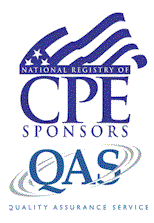Celebrating 25 years serving our friends and customers!
FASB ReviewCode: 24-FASB
Add to Cart
Course Details
500 pages
Objective: To review recent accounting changes important to accountants in industry.
The purpose of this course is to inform the reader of the various changes affecting accounting and financial reporting, as well as a review and recall of existing accounting standards. Topics include a summary of newly issued FASB statements, current and pending developments, practice issues, a discussion of accounting and financial reporting issues related to COVID-19, the CARES Act and PPP loans, and more.
Major Topics:
- Identify types of subsequent events that require disclosure
- Recognize some types of concentrations that might require disclosure under the risk and uncertainty rules
- Identify the definition of near term
- Recall the frequency in which an entity should test goodwill for impairment
- Recognize the formula for testing goodwill impairment
- Recall how to classify business interruption insurance proceeds on the financial statements
- Identify a method that can be used to measure variable consideration revenue
- Recognize an example of a construction-type contract
- Identify a tax-law change made by the CARES Act, and
- Recognize how a company should present CARES Act loan forgiveness on its financial statements.
- Identify a characteristic of a multi-employer plan
- Recall the color coding of funded status of a multi-employer plan
- Recognize an argument for not amortizing goodwill
- Identify an example of a customer-related asset
- Recognize a key change made to GAAP by the new lease standard
- Identify a type of lease that exists for a lessee under ASU 2016-02
- Recall a type of lease for which the ASU 2016-02 rules do not apply
- Recognize some of the criteria that determine whether a contract is or is not a lease
- Identify how a lessee should account for initial direct costs
- Recall how a lessor should initially account for initial direct costs for a lease in certain instances
- Identify how a lessor should account for lease payments received on the income statement for an operating lease
- Recognize how certain existing leases are accounted for on the implementation date of ASU 2016-02
- Recall the potential impact that the new lease standard might have on a lessee's EBITDA
- and debt-equity ratios.
- Identify the category of securities for which ASU 2016-01 retains the three categories under existing GAAP
- Recall one of the changes made by ASU 2016-01 to existing GAAP for financial instruments.
- Recall how available-for-sale debt securities are measured on an entity's balance sheet
- Identify how held to maturity securities are measured on the balance sheet
- Recognize how an entity should account for a temporary impairment
- Recall how an entity should present an unrealized gain or loss on an equity security under ASU 2016-01
- Identify how a mutual fund that invests in debt and equity securities should classify the investment
- Recall a change made to the exemption for fair value disclosures with respect to trade receivables and payables
- Recognize the model that ASU 2016-13 uses to deal with credit losses
- Identify how credit losses should be recorded under new ASU 2016-13
- Identify some of the disclosures required by ASU 2016-13
Presentation Method: Self-Study
Category: Accounting
CPE credit: 16 Hours
Program Level: Update
Prerequisites: None
Advance Preparation: None
Exam expiration date: Participants must submit exams for grading within one year from the date of purchase



